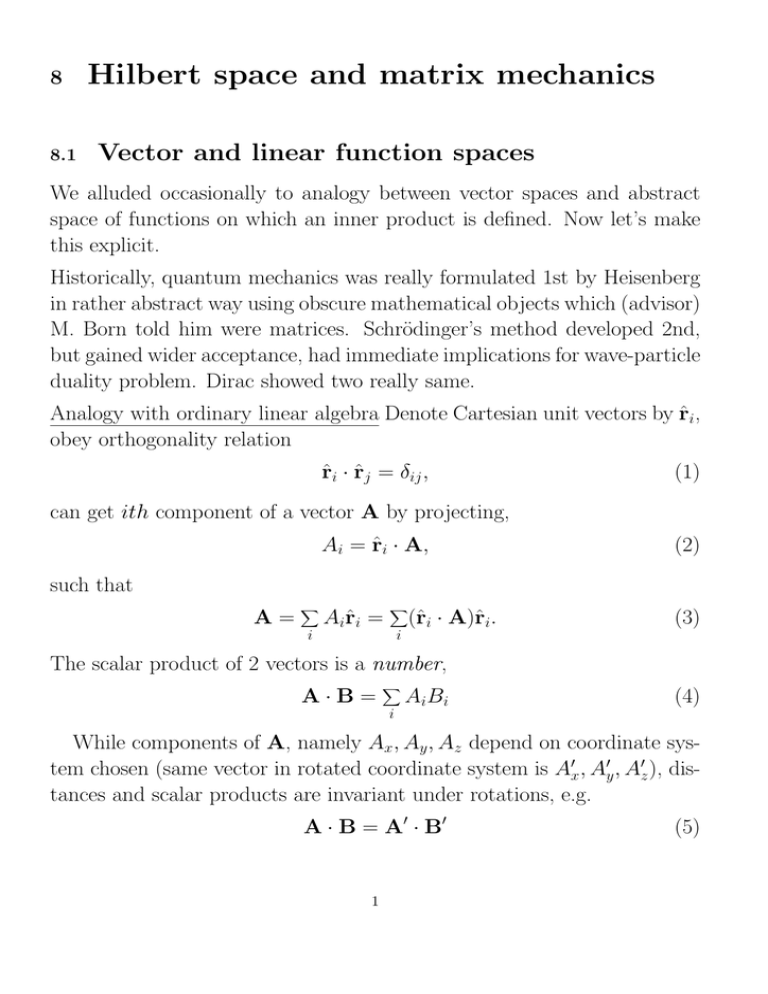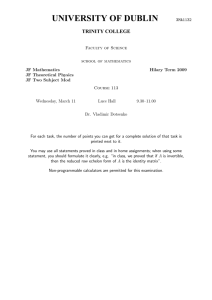Hilbert space and matrix mechanics Vector and linear function spaces
advertisement

8
8.1
Hilbert space and matrix mechanics
Vector and linear function spaces
We alluded occasionally to analogy between vector spaces and abstract
space of functions on which an inner product is defined. Now let’s make
this explicit.
Historically, quantum mechanics was really formulated 1st by Heisenberg
in rather abstract way using obscure mathematical objects which (advisor)
M. Born told him were matrices. Schrödinger’s method developed 2nd,
but gained wider acceptance, had immediate implications for wave-particle
duality problem. Dirac showed two really same.
Analogy with ordinary linear algebra Denote Cartesian unit vectors by r̂i,
obey orthogonality relation
r̂i · r̂j = δij ,
(1)
can get ith component of a vector A by projecting,
Ai = r̂i · A,
(2)
such that
A=
X
i
Air̂i =
X
i
(r̂i · A)r̂i.
(3)
The scalar product of 2 vectors is a number,
A·B=
X
i
AiBi
(4)
While components of A, namely Ax, Ay , Az depend on coordinate system chosen (same vector in rotated coordinate system is A0x, A0y , A0z ), distances and scalar products are invariant under rotations, e.g.
A · B = A0 · B0
1
(5)
Now think of wave function ψ describing quantum-mechanical state as
vector in large space. Let {ψn} be complete set of eigenstates of some
observable. Can always arrange that ψn are orthogonal. Assume discrete
e’values for now =⇒
(ψn, ψm) = δm,n
(6)
(compare Eq. (1)). Completeness assumption is that any physically acceptable function φ can be expanded in terms of the ψn,
φ=
X
n
c n ψn ,
(7)
which looks like Eq. (3). Expansion coefficients cn thus completely specify
state φ, can be thought of as components of vector. Inner product with
P
χ = n dnψn is
(φ, χ) =
X
n,m
c∗ndm(ψn, ψm) =
X
n
c∗ndn
(8)
also a number like Eq. (4).
Suppose we have a different basis set of complete eigenfctns. {ηn}. Then
the “components” of φ will look different in the new basis,
φ=
X
n
c0nηn
(9)
but inner products will be invariant,
(φ, χ) = (φ0, χ0)
(10)
Continuous eigenvalues:
Suppose eigenfunctions ψq have continuous eigenvalue q, meaning no
gaps between allowed values of q. Example to keep in the back of your
mind: plane waves ψp = eipx for infinite system.
Then orthogonality condition is
(ψq , ψq0 ) = δ(q − q 0),
can expand
2
(11)
Z
Z
φ = dq c(q)ψq ; χ = dq d(q)ψq
c(q) = (φ, ψq ) ; d(q) = (χ, ψq ),
Z
and (φ, χ) = dq c(q)∗d(q)
(12)
(13)
(14)
Although expressions involve integrals rather than discrete sums, formally
analagous to discrete case: can regard φ as vector w/ components given
by expansion coefficients.
8.2
Dirac’s Bra (hψ|) and Ket (|ψi) notation
• Physical system will now be described by vector in linear space (“Hilbert
space”), written as
|ψi,
|φi,
|n, `, mi, . . .
(15)
Might write particular eigenstate of H-atom as |n, `, mi— letters simply label quantum state. Will also use
|ri for single particle located at
position r (? not ψ(r))
|pi for particle with definite momentum p
(16)
(17)
(18)
• Space is linear:
If |ψi, |φi elements of space, with α, β constants, then
|χi = α|ψi + β|φi
is also an element of the space.
3
(19)
• Dual space:
For every vector |ψi we have an associated dual or adjoint vector hψ|.
In ordinary matrix algebra |ψi may be thought of as column vector,
hψ| as row vector!
• Inner product.
For every pair |ψi, hφ| we assign complex no. hφ|ψi with following
properties:
1. hφ|ψi∗ = hψ|φi
? Note this implies that the dual of α|ψi is α∗hψ|.
2. hφ|φi real, > 0 unless |φi = 0.
3. linearity: hψ|(α|φi) = αhψ|φi,
hψ| (α|φi + β|χi) = αhψ|φi + βhψ|χi.
N.B. Dual space is also linear
• Operators
Linear operators in this space defined by
Q̂|ψi = |ψ 0i,
(20)
a new vector in Hilbert space. Linearity means
Q̂ (α|ψi + β|φi) = αQ̂|ψi + β Q̂|φi
(21)
? All rules for addition and multiplication of operators hold as in
Schrödinger representation.
• Operators on dual space
This is a little tricky: action of operator Q̂ on dual vector hψ| is
hψ|Q̂ = hψ 0|,
4
(22)
also a vector in the dual space. Meaning of hψ 0| is, for any |φi,
hψ 0|φi = hψ| (Q̂|φi) ≡ hψ|Q̂|φi
(23)
• Adjoint of operator
Def.:
Dual of Q̂|ψi is hψ|Q̂†
(24)
Frequently I’ll be sloppy and write this as
( Q̂|ψi )† = hψ|Q̂†
(25)
? All rules for adjoint we proved for S.-representation continue to hold,
e.g.
(AB)† = B †A†
(26)
hφ|Q̂|ψi∗ = hψ|Q̂†|φi
(27)
and
• Eigenstates and eigenvalues
1. Eigenvalue eqn. for self-adjoint operator Q̂ is
Q̂|ψi = q|ψi
2. E’values of self-adjoint op. are real:
hφ|Q̂|φi = qhφ|φi
hφ|Q̂†|φi = q ∗hφ|φi
so q = q ∗ if Q̂ = Q̂†.
5
(28)
3. E’states belonging to different e’values are orthogonal:
Assume
Q̂|q1i = q1|q1i
Q̂|q2i = q2|q2i
Then notice Q̂ can act either to left or right:
hq1|Q̂|q2i = q2hq1|q2i
= q1hq1|q2i
(29)
(30)
So if q1 6= q2, must have hq1|q2i = 0.
• Completeness:
Any Hilbert space vector |ψi can be expanded
|ψi =
X
n
cn|ni
(31)
in terms of some complete set |ni > of e’states of some self-adj. operator Q̂, e’values qn assumed discrete for moment. The |ni > may
be chosen orthonormalized,
hm|ni = δmn
(32)
so expansion coeffs. cn may be expressed (multiply Eq. (31) by hm|!)
cn = hn|ψi
(33)
or
|ψi =
X
n
= (
|nihn|ψi
X
n
6
|nihn| ) |ψi
(34)
(35)
P
So we can think of expression n |nihn| as being a kind of operator,
and from Eq. (35) we see it had better be the identity. This will be
true if the |ni span the whole space, i.e. completeness means
X
n
|nihn| = 1
(36)
continuous e’values:
Orthogonality :
hq|q 0i = δ(q − q 0) ,
similar arguments give
=⇒
Z
|ψi =
Z
dq |qihq|ψi
(37)
dq |qihq| = 1
(38)
• Analogy with matrices, row and column vectors:
Any state |ψi specified completely by giving all the “components”
hn|ψi ( see Eq. (34) ).
Same is true for state Q̂|ψi:
hn|Q̂|ψi =
X
m
hn|Q̂|mihm|ψi
(39)
Now note this looks like a matrix equation relating column vectors
hn|ψi and hn|Q̂|ψi :
h1|Q̂|ψi
Q11 Q12 Q13 · · · h1|ψi
h2|Q̂|ψi
Q21 Q22 Q23 · · · h2|ψi
=
h3|Q̂|ψi
Q31 · · ·
h3|ψi
...
...
...
...
(40)
where the matrix elements of the operator Q̂ are just
Qmn = hm|Q̂|ni
7
(41)
Also since
hψ|Q̂|ni =
X
m
hψ|mihm|Q̂|ni,
(42)
can think of hψ|ni and hψ|Q̂|ni as row vectors:
Q11 Q12 · · ·
(hψ|Q̂|1i hψ|Q̂|2i · · ·) = (hψ|1i hψ|2i · · ·) Q21 Q22 · · ·
...
(43)
Now we can make contact with the matrix algebra terminology, e.g.
adjoint of matrix A specified by elements Amn is mat. A† with elements A∗nm. For our self-adjoint observables Q̂,
(Qmn)∗ =
=
=
=
hm|Q̂|ni∗
hn|Q̂†|mi
hn|Q̂|mi
Qnm
(44)
In linear algebra such a matrix called Hermitian.
Q = Q† ≡ (QT )∗
(45)
• Relation to our friend the wavefunction
|ri represents state with particle definitely at position r. Note this
provides continuous orthonormal basis:
hr|r0i = δ(r − r0)
In this basis state vector has “components”
8
(46)
hr|ψi ≡ ψ(r) = Schrödinger’s wavefctn
hψ|ri = ψ ∗(r)
(47)
(48)
so we can “expand” state |ψi in this basis:
|ψi =
Z
3
d r|rihr|ψi =
Z
d3r|riψ(r)
(49)
Given 2nd state
|φi =
Z
d3r|riφ(r)
(50)
we can take the inner product:
Z
3
3 0
0
∗
0
Z
hψ|φi = d rd r hr |riψ (r ) = d3rψ ∗(r)φ(r)
≡ (ψ, φ)
(51)
to recover old notation explicitly!
• Time dependence
Objective: “derive” Schrödinger eqn” from scratch! Pretend you are
Heisenberg, and only know about state vectors in linear spaces. Given
system is in state |ψ(t1)i, assume |ψ(t2)i related to it by linear operator Û :
|ψ(t2)i = Û (t2 − t1)|ψ(t1)i
(52)
with Û unitary, Û Û † = 1. For infinitesimal δt = t2 − t1, can Taylor
expand:
Û = 1 − iHδt/h̄,
(53)
So far don’t know what H is really, merely plays role of 1st order
Taylor coefficient in time evolution of Û (did pull out factor of h̄ to
9
make sure it has dimensions of energy, however!) Now plug (53) into
(52), rearrange:
−iH|ψ(t1)i
|ψ(t1 + δt)i − |ψ(t1)i
=
, or
δt
h̄
∂|ψi
ih̄
= H|ψi
∂t
(54)
which as we’ve said has formal solution
Û (t) = e−iHt/h̄
(55)
• Matrix mechanics → wave mechanics
sketch of Dirac’s ideas:
– Replace Poisson brackets in classical mechanics with commutators in quantum mechanics. Recall P.-bracket of two functions
f (qi, pi), g(qi, pi) of the coordinates qi and momenta pi in class.
mech. defined by
∂g
∂f
X ∂f ∂g
(56)
−
{f, g} ≡
∂q
∂p
∂p
∂q
i
i
i
i
i
With this definition, Newton’s laws/ Hamilton’s equations may
be written generally as eqn. of motion for any fctn f (qi, pi) (See
any adv. class. mech. book):
d
f = {f, H}
(57)
dt
e.g. take f = p, H = p2/2m + V (x), find
dp/dt = −∂V /∂x
10
(58)
– What is starting point for sensible quantization procedure? ’Til
now had guess for momentum operator based on free particle case,
similar ad hoc guesses. Dirac: take as gospel commutation relations between operators, e.g. p, r̂,
?
replace {ri, pj } = δij → [r̂i, p̂j ] = ih̄δij .
(59)
– Calculate matr. elts in |ri basis of [r̂i, p̂j ] = ih̄δij :
hr| × [r̂i, p̂j ] = ih̄δij × |r0i
= (ri − ri0 )hr|p̂j |r0i = ih̄δij δ(r − r0)
∂
δ(r − r0)
= ih̄(ri − ri0 )
∂rj
(60)
(? last step a bit mysterious–exercise for reader!)
This says what p does to state |ri, therefore to |ψi:
p = −ih̄∇
(61)
as we found before by vague arguments about the free particle
case, plane waves, etc. (see sec. 4).
– H = p̂2/2m + V (r) is time evolution operator in sense of (55).
How do we know this?
• Heisenberg representation
Choose orthonormal set of vectors |ni ≡ |n; 0i at time t = 0. If we
allow them to evolve according to Eq. (54), at a later time t they will
be |n; ti, with
|n; ti = e−iHt/h̄|n; 0i
They’ll still be a complete orthonormal set, though:
11
(62)
hn; t|m; ti = (hn|eiHt/h̄)(e−iHt/h̄|mi)
= hn|mi = δmn
(63)
so we could expand an arbitrary state vector |ψ(t)i in terms of these
basis vectors with constant coefficients:
|ψ(t)i =
X
n
cn|n; ti
(64)
In Heisenberg rep., express everything in terms of t − independent
state functions |ψi ≡ |ψ(0)i (characterized by |c1, c2 . . .i.) Operators
on other hand become t − dependent, with matrix elements:
Qnm(t) ≡ hn; t|Q̂|n; ti.
(65)
Time derivative of matrix:
d
∂
∂
Q̂ = ( hn; t|)Q̂|n; ti + hn; t|Q̂ |n; ti
dt
∂t
∂t
i
= [H, Q̂]
h̄
(66)
Eq. (66) sometimes called Heisenberg eqn. of motion. Completely
analogous to classical Poisson bracket equation, Eq. (57). Thus
without reference to specific form of “H”, canonical quantization of Dirac tells us the mysterious time evolution
operator “H” in Eq. (54) is the Hamiltonian of the system!
=⇒ equivalence of matrix and wave mechanics.
12


